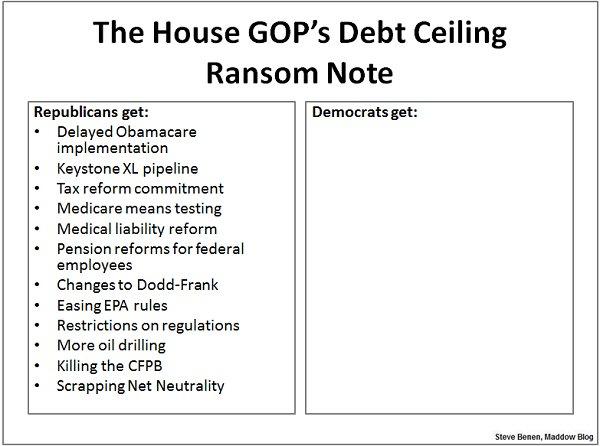
Speaker of the House John Boehner (R-OH) walks to the chamber as the House of Representatives works into the night on Saturday, Sept. 28, 2013. (Photo by J. Scott Applewhite/AP)
It’s almost certain that we’ll see the government shut down on Tuesday. The last time that happened, in 1996, it cost $2.1 billion in today’s dollars. Breaching the debt limit would be far, far worse — nobody knows how bad, exactly, but everyone agrees that it would be really bad. The risk of finding out has never been greater. This showdown is by far the most dangerous of a series of fiscal “crises” that have been contrived during the Obama presidency.
Beltway reporters who see their professed neutrality as a higher ground bear an enormous amount of responsibility for encouraging this perversion of democratic governance. With a few notable exceptions, the media have framed what Jonathan Chait called “a kind of quasi-impeachment” in typical he said-she said fashion, obscuring the fact that the basic norms that govern Congress have been thrown out the window by a small cabal of tea party-endorsed legislators from overwhelmingly Republican districts. The media treat unprecedented legislative extortion as typical partisan negotiations, and in doing so they normalize it.
But it’s not normal. Republicans are demanding that Democrats unwind their signature achievement — a piece of legislation that took 18 months to pass, survived a Supreme Court challenge and a presidential election — in exchange for a stopgap budget resolution. On Saturday, they tacked on a provision that would limit access to contraceptives.
Then there’s the other hostage — the debt ceiling. Consider the list of demands Speaker of the House John Boehner (R-OH) issued last week for raising it, as reported by Ezra Klein:
In return for a one-year suspension of the debt ceiling, House Republicans are demanding a yearlong delay of Obamacare, adoption of House Budget Committee Chairman Paul Ryan’s tax-reform plan, construction of the Keystone XL pipeline, more offshore oil drilling, more drilling on federally protected lands, looser regulations around ash coal, a suspension of the Environmental Protection Agency’s regulation of carbon emissions, more power over the regulatory process in general, reform of the federal employee retirement program, changes to the Dodd-Frank Act, more power over the Consumer Financial Protection Bureau’s budget, repeal of the Social Services block grant, expanded means-testing for Medicare benefits, repeal of the public health trust fund and more.
This opening gambit is virtually unprecedented. In the past, a few minor sweeteners have been tacked onto debt-limit hikes. Debt limit increases have also been added to budget bills negotiated separately by the parties in order to avoid a vote altogether. What makes the current ploy novel is they are offering essentially the entirety of Mitt Romney’s agenda — in essence, a demand to do over the 2012 election and, while they’re at it, 2008 as well.
Yet you wouldn’t fully appreciate the audacity of this tactic by reading standard Beltway coverage. As Brian Beutler notes in Salon, TIME magazine reporter Zeke Miller calls this “negotiating technique… is by no means novel. Hostage taking — by promising harm if you do not get your way — has long been a standard way of doing business in Washington.” James Fallows, decrying what he calls a “failure of journalism,” flagged the headline, “Parties Digging in Their Heels as Hourglass Empties.” (The Courier-Post, a Gannett paper, similarly went with, “Lawmakers dig in their heels; government shutdown nearer.”) And Politico’s Jake Sherman and John Bresnahan described the ransom note as simply a set of “demands for reform.” All of this coverage reeks of false equivalency, implying yet again that “both sides do it.”
Let’s conduct a brief thought exercise.
In 2007, Democrats controlled both chambers of Congress and had deep political differences with then-President George W. Bush. Yet they passed a clean debt limit increase, with about as many Democrats as Republicans voting “aye.”
But imagine, for a moment, that Democrats had held the House two years earlier, in the fall of 2005, less than a year after Bush’s re-election. And imagine further that in exchange for not breaching the debt limit and bringing economic catastrophe down on the citizens of the United States, they had demanded that the Republican Senate pass, and the Republican president sign into law, all of the following: single-payer health care, a federal living wage law (indexed to inflation, of course), the elimination of all oil subsidies, a roll-back of Bush’s tax cuts on high earners, strict limits on campaign financing, new regulations of greenhouse gas emissions and an immediate withdrawal from Iraq.
This imagined list of 2005 demands is no further from the majority’s agenda than what House Republicans offered Democrats and the White House last week. Yet it’s hard to imagine that Politico would have dismissed this 2005 list as merely “demands for reform,” or that TIME would have suggested that such maneuvers were routine — the narrative would have been that Dems had gone completely bonkers.
The difference is that, with a demographic tide going against them, Republicans have gradually jettisoned the norms that make democratic governance possible. First they filibustered virtually everything. Then they started creating these annual budget showdowns to fight for cuts in taxes and spending. Now they’re using the budget battle to advance the entire legislative agenda of the hard right. In essence, they have made crisis governance the new normal — but they did so incrementally.
Like frogs in the proverbial pot, many journalists have slowly acclimated to these extreme, democracy-suffocating circumstances and now seem incapable of describing what they’re seeing. Framing everything as a standard-issue partisan fight is almost a professional imperative for many journalists. But there are three reasons this is wrong.
First, this showdown has been authored by a relatively small number of Republican officeholders with just enough votes to force their leadership into a battle that will ultimately hurt the country.
This important piece of information is often buried in Beltway coverage. Another Politico piece by Jake Sherman and John Bresnahan frames the “standoff” as “Senate Democrats and the White House at loggerheads with House Republicans” in the fourth paragraph. It’s only in the second-to-last paragraph that they acknowledge that it’s really “a small group of conservatives that have tied the hands of Boehner, Majority Leader Eric Cantor (R-VA) and Majority Whip Kevin McCarthy (R-CA) — just enough Republicans to prevent the leadership from being able to exert its will.”
One reporter who got it right, The New Yorker’s Ryan Lizza looked at the 80 Republican lawmakers who signed a letter demanding that the party attempt to “defund Obamacare” — Lizza dubs them the “suicide caucus” — and noted that they “represent just 18 percent of the House and just a third of the 233 House Republicans.” And they are political outliers:
These 80 members represent an America where the population is getting whiter, where there are few major cities, where Obama lost the last election in a landslide, and where the Republican Party is becoming more dominant and more popular. Meanwhile, in national politics, each of these trends is actually reversed.
Meanwhile, a number of Republican legislators have condemned the tactics pushed by the “suicide caucus,” and others have hinted that they’d be willing to vote for a “clean” budget resolution (and presumably a debt limit hike).
Go back to our thought exercise: what if Speaker Nancy Pelosi had wanted to pass a clean debt limit hike in 2005, but the Congressional Progressive Caucus had forced her to demand single-payer health-care and the rest? It’s unfathomable.
The second reason the standard-issue Beltway framing is wrong is it doesn’t capture the nature of the so-called “negotiation.”
A negotiation is between two parties that want different things and come to some compromise. Nobody should want a shutdown or a default and passing budgets and paying the federal government’s debts aren’t Democratic priorities. Rather, what we are seeing now is a “negotiation” in which Republicans are demanding a lot and offering absolutely nothing in return. MSNBC’s Steve Benen offered a handy chart to make this point clear:
Third, the “digging in their heels” narrative doesn’t work, because when it comes to the budget resolution, the Republicans have already won. They just refuse to acknowledge it.
In March, the Republican-controlled House and Senate Democrats passed dueling spending bills. The House locked in most discretionary spending at levels below those set by the “sequester,” while increasing defense spending. The Senate bill assumed that the sequester would end.
Last week, the continuing resolution the Senate sent back to the House set spending levels at about what House Republicans called for back in March. As Jon Healey wrote in the Los Angeles Times, “Republicans: You won the battle over the stopgap spending bill. Time to declare victory and move on.”
The reason all of this is important is simple: A faction within one of our parties has rejected the basic structure of our democratic system — the separation of powers. The only thing that will break the fever that grips them — the only thing that can break the fever — is intense public backlash, and not just from Democratic partisans, but also from the majority of Republicans who don’t identify with the tea party movement and oppose these antics. By muddying the waters of what’s really going on here with their perpetual false equivalence, the Beltway media is making that reckoning unlikely to occur.



